
The VR Coach smart system for treating phobias.
We have developed various interactive VR scenarios and 360-degree films for the treatment of phobias. All content on this page is part of the software package for phobias.

Successfully Treat Phobias with Interactive VR Therapy
Our VR therapy software provides clinics and therapy practices with a modern, effective treatment method for exposure therapy in specific phobias.
Customizable VR Scenarios for Exposure Therapy
With realistic, controllable VR scenarios, therapists can specifically address their patients' fears and tailor the exposure to each individual's needs.
Explore all active VR therapy scenarios for treating specific fears – from fear of heights to needle phobia. For more information, simply click on "Details."

Subway station

Riding the subway is a challenge for many people with anxiety disorders. Waiting on a crowded platform or entering a narrow subway car with unfamiliar passengers can quickly lead to stress-inducing situations. This scenario is especially suitable for patients with social phobia or agoraphobia.
Description of the scenario
Once your patient puts on the VR headset and you start the scenario, they will either be directly inside a moving subway or on a busy platform. In the subway, they are initially alone, but passengers can be added if needed. On the platform, other people are either walking around or waiting for the next train.
The avatars can be optionally activated – they stand, sit, or move like real passengers. When Text-to-Speech is enabled, they respond to the patient with eye contact.
The patient has the following possibilities for a high degree of realism:
- Free movement through the subway and station
- Getting on and off at any station
- Sit on any seat in the car (Note: Prepare a real chair in the therapy room for this)
The therapist can activate the following actions in this scenario:
- Start or arrival of the subway
- Simulation of a stalled train
- Toggling the avatars on or off
- Regulate crowd size (using a slider)
- Deactivate automatic door opening
- Make avatars smile or give a provocative look
- Individually control announcements in the subway
- Activate individual dialogues through Text-to-Speech*

Subway station
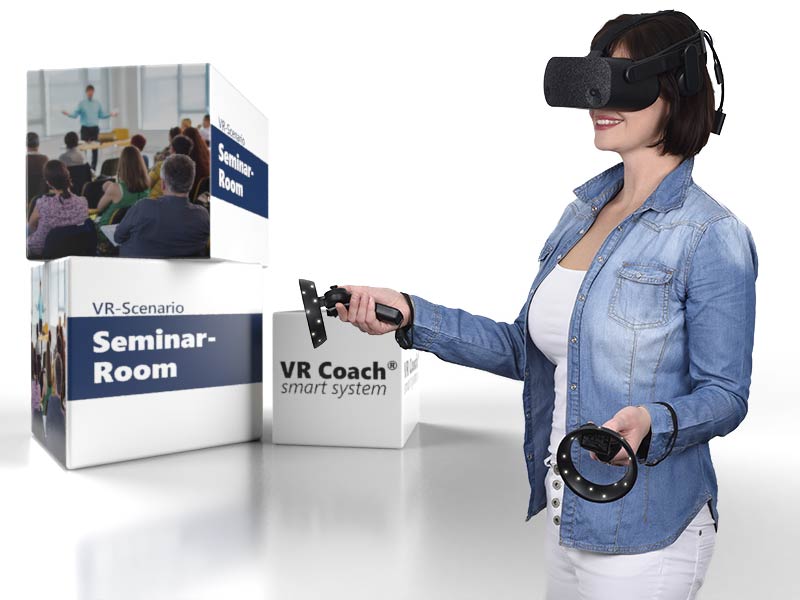
Seminar room

Treatment of social phobia and preparation for lectures, job interviews and examinations
Speaking in front of an audience is one of the greatest fears of all! Whether for presentations, job interviews or examinations: With this scenario you can help your patients in a completely new way.
Description of the scenario
At the start of the scenario, the patients find themselves in the entrance area of the room. The patient walks himself or herself or teleports to the middle of the room by clicking on the controller. In front of them, there are tables set up in a U-shape with 12 people sitting there.
The patient can now begin their lecture. The therapist can trigger different reactions from the audience during this time. Specifically:
- Restlessness
- Laughter
- High attention level
- Someone raises a hand to ask a question*
Additional feature
- The therapist can change the scenario with a click, so that the patient is sitting in front of only three people.
- Again, the therapist may have a person raise their hand to ask a question.
- The therapist can also activate a stage scene with hundreds of listeners. The patient can move around on a large stage. The listeners automatically follow their movement and thus maintain eye contact. The reactions described above are also possible here.
- Individual conversations between avatars and patients. *
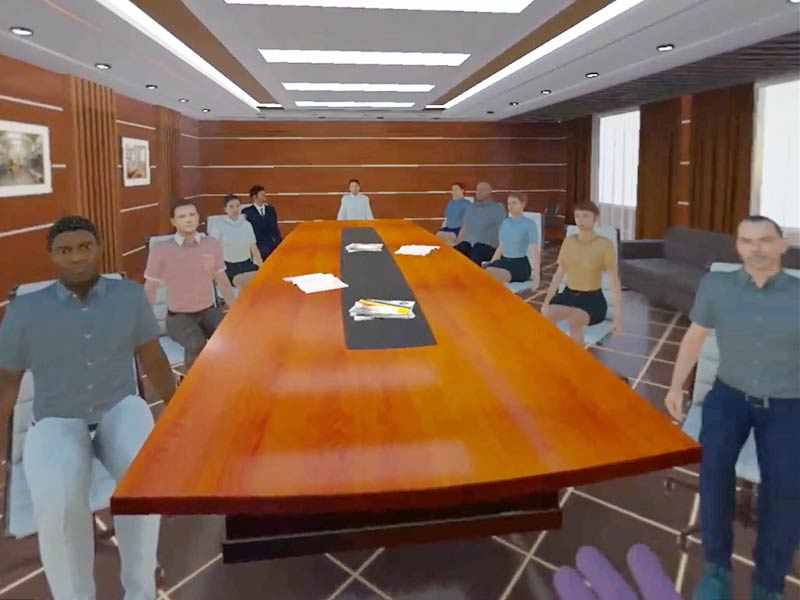
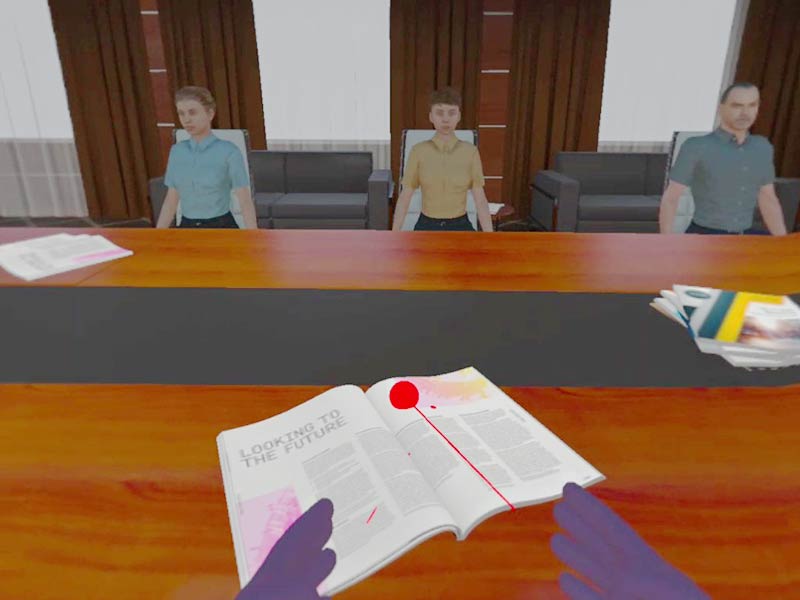
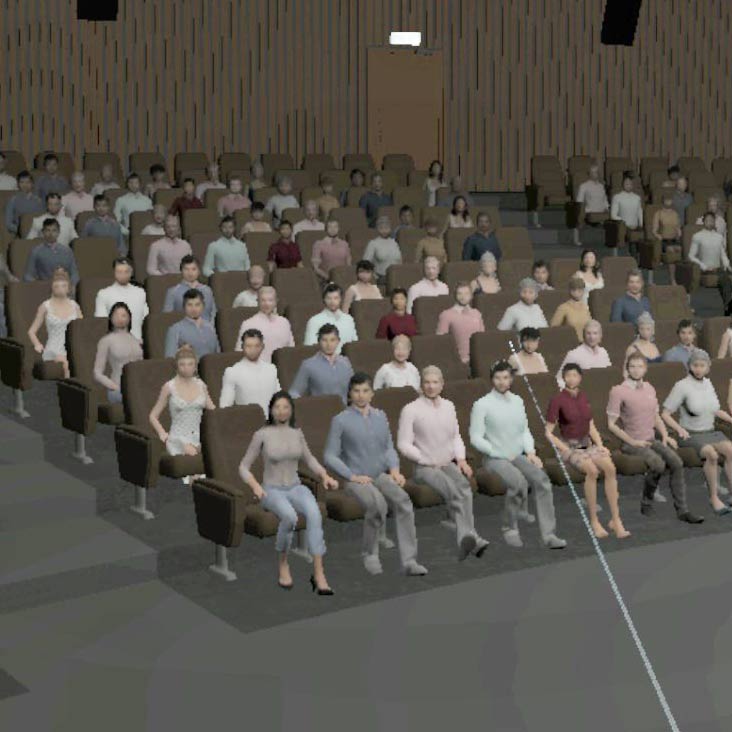
Seminar room
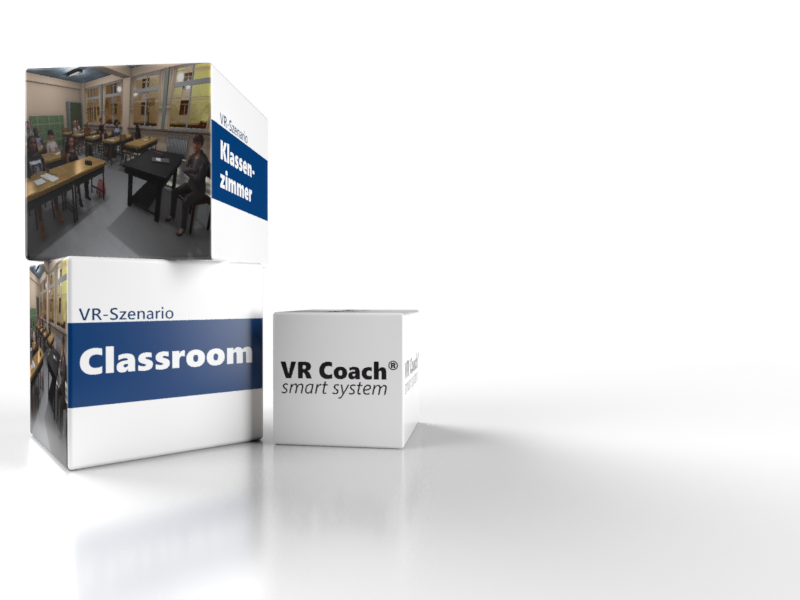
Classroom

Treating social anxiety in adolescents
Being assessed by teachers can lead to anxiety disorders in some young people. In this scenario, assessment situations are faced in a classroom.
Description of the scenario
At the start of the scenario, the patients are in the entrance area of the classroom. The patient walks himself or teleports himself to the middle of the classroom by clicking on the controller. In front of him are typical school desks with teenage avatars. The avatars are so-called scanned avatars and are therefore images of real people, which increases graphic realism. A teacher sits next to the patient and observes him.
The patient can now, for example, start a lecture. The therapist can trigger different reactions from the audience during this time. Specifically:
- Restlessness
- Laughter
- Foreign shame gesture
- Intensive eye contact with the patient
More features
- An individual dialogue can be triggered between teacher and patient. The teacher’s texts can be defined by the therapist and written into the software.
- The students can also speak texts set by therapists.
- Patient can also write on the board.

Classroom
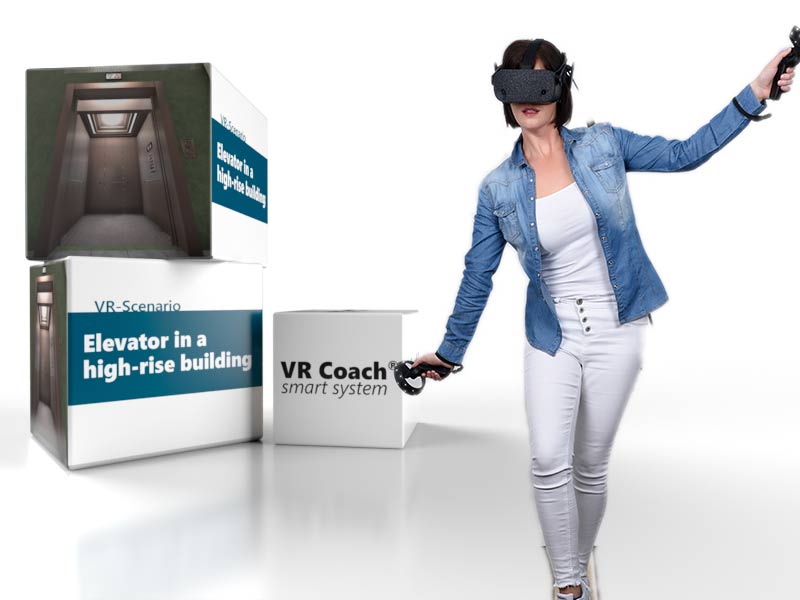
Elevator in high-rise building

Treatment of claustrophobia and panic
Elevators are predestined to trigger feelings of tightness and panic in your patients.
Description of the scenario
To start with, the patients are located near an elevator. Using the teleport function, you can move to the elevator door. You use your virtual hand to call the elevator and then walk in with your own steps. Once inside, you choose which floor you want to go to. then the door closes and the elevator starts moving.
The following interactions are available for patients:
- Call elevator by pressing button
- Take your own steps
- Select floor. Go out again later
The following setting options are available for therapists:
- The size of the elevator can be specified (small, medium, large)
- The driving speed can be set
- Stressful situations can be triggered: the elevator starts to shake. Elevator gets stuck and an alarm sounds
- The back wall can be customized: plain back wall, mirror or window with a view to the outside


Elevator in high-rise building
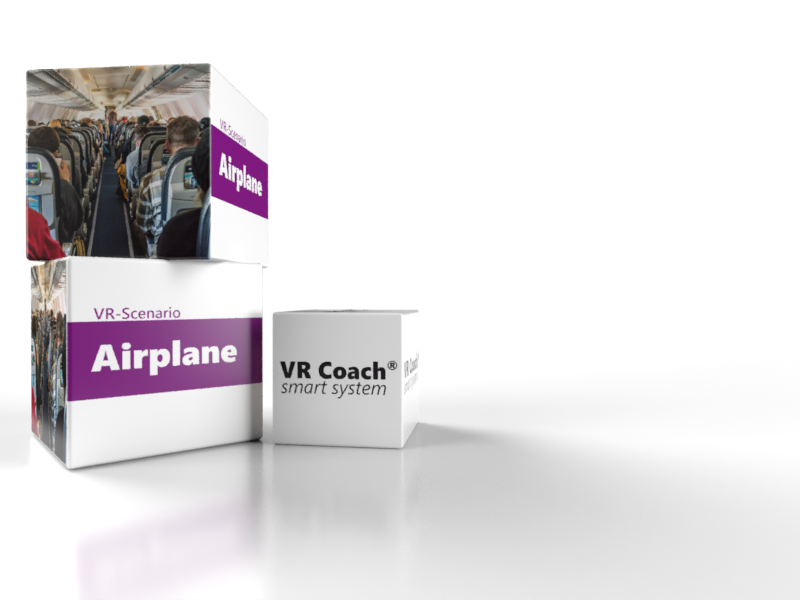
Airplane

Treatment of aviophobia, claustrophobia and agoraphobia
The fear of airplanes does not only come from a fear of flying. The expected lack of space and the feeling of being far away from home can also trigger reactions of panic. With this scenario you can help your patients to cope with private and professional travel.
Description of the scenario
At the beginning, the patient stands in the aisle of the aircraft, takes a few steps and looks for an empty seat. There are two free seats on one side. The patient clicks on a seat and teleports there. The patient should now also sit down in your practice.
On the plane, the patient experiences a typical atmosphere a few minutes before take-off. They can look out of the window or at the monitor in front of them, where a relaxation video is playing.
The therapist can activate the following interactions in this scenario: Specifically:
- Start – by looking out of the window and via the engine noises getting ever louder, an authentic starting experience is created. After a few minutes, the aircraft switches to normal flight mode.
- Landing – here too, the patient experiences a realistic descent followed by a landing.
- The seat next to the patient can be occupied by a stranger or left vacant.
- The therapist can trigger an announcement that there will be some turbulence shortly.
- The therapist can trigger turbulence. The whole environment shakes. The other people sitting next to the therapist also react with corresponding movements and there is an acoustic clattering.
- The therapist can trigger a false alarm with masks falling down and passengers screaming in terror.
- Individual conversations between passengers and patients *
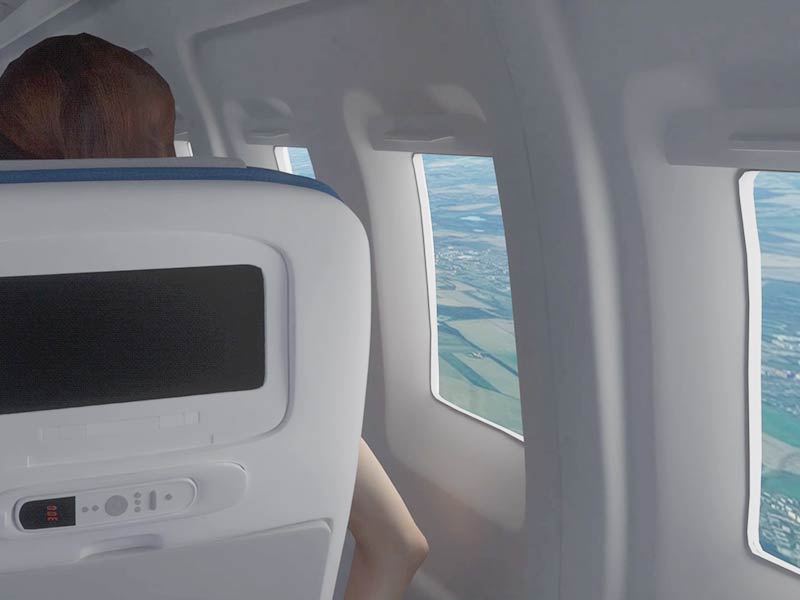
Airplane
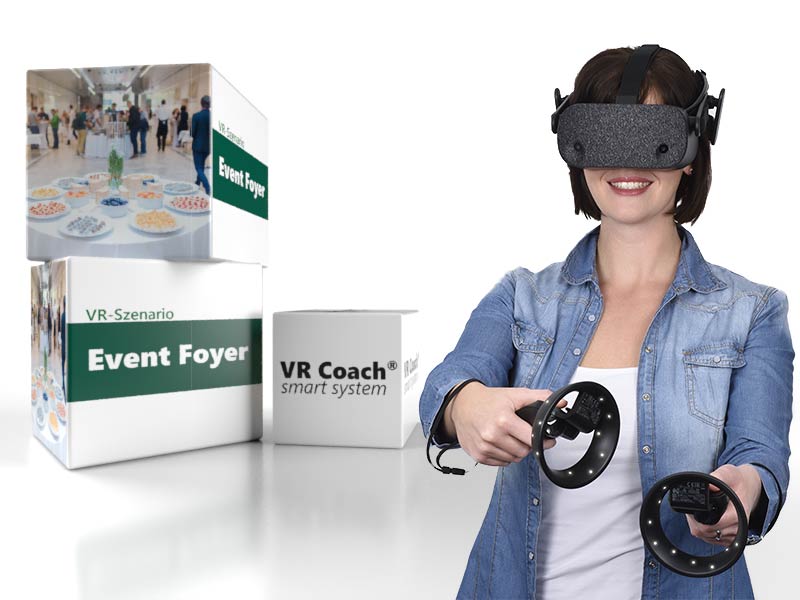
Event foyer

Treatment of social phobia and shyness
Sit at a table with strangers, make contact, engage in small talk, network – for many people with social phobia or similar problems, this is a task that is almost impossible to solve. With this scenario you can help your patients to deal with it!
With this scenario you can help your patients to deal with it!
Description of the scenario
The patient is in the corner of a large common room, from where he or she has a good overview of what is happening.
He/she can walk through the room themselves or teleport to certain points by clicking on the controller.
On one side of the room there is a buffet table with drinks and food.
The therapist can use many features in this scenario.
Specifically:
- The therapist can increase the number of tables from 0-7 with 2 people respectively on each.
- The patient can approach each table where the people are sitting.
- The therapist can trigger positive or negative feedback from the people
- Set individual conversations between avatars and patients. *
Further interaction possibilities in the waiter game
- The patient can take the tray in one hand.
- The therapist can trigger a drink order by the hand movement of one of the people.
- The patients can serve a drink to this table.
- The therapist can also trigger positive or negative feedback here.
Further features on the topic of “food”
- The patient can take a plate with pizza or a cake on it.
- The patient can go through the room whilst carrying this plate and can then place it on a bar table or can bring it back.
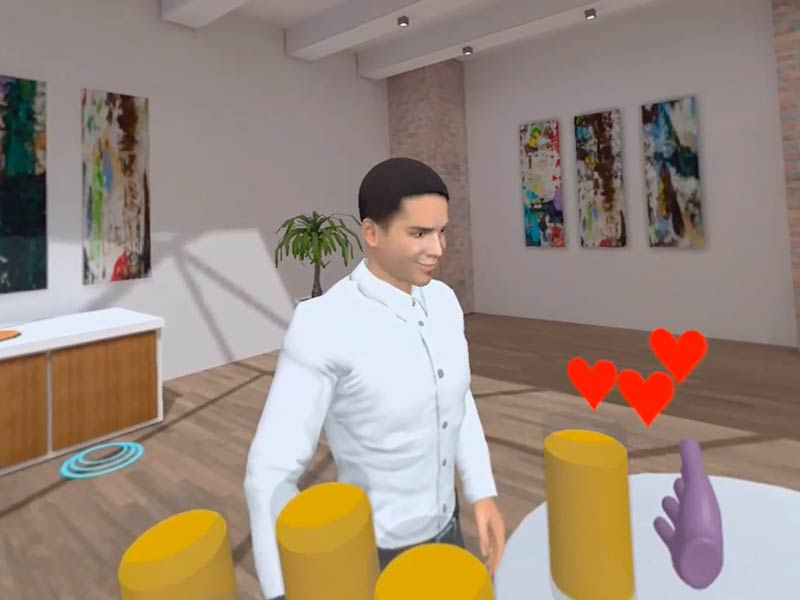
Event foyer
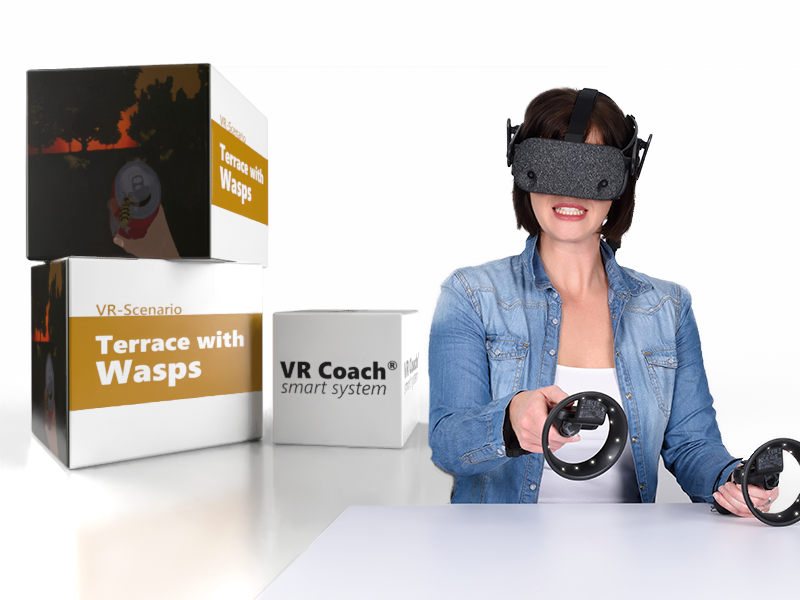
Terrace with Wasps

The patients start outdoors on a terrace. Using the teleport function, they can move throughout the entire garden. A wasp is always present from the beginning.
The therapist can activate the following actions in this scenario:
- Toggle the wasps on/off
- Toggle protective equipment on/off
- Make the wasps follow the patient
- Make the wasps follow the can
- Make a wasp land on the can
- Trigger a wasp sting
- Adjust the number of wasps


Terrace with Wasps
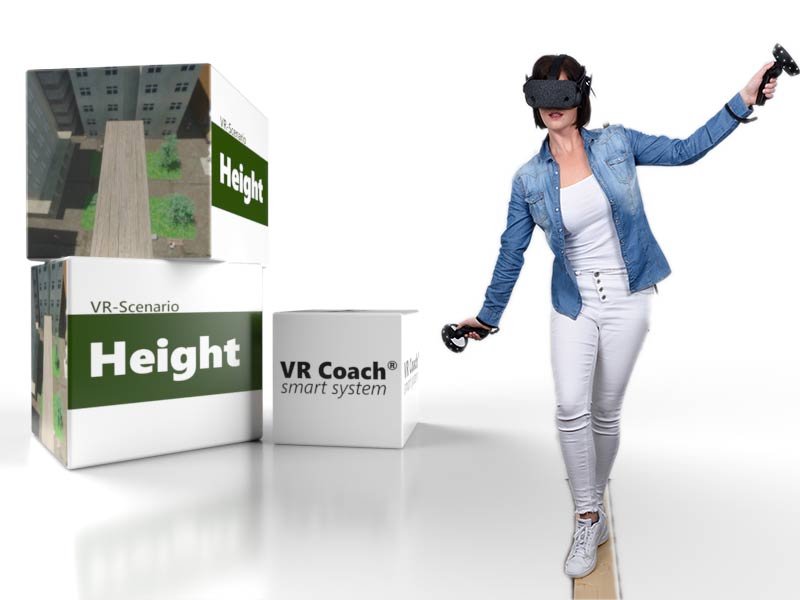
Height

Description of the scenario
The patient is standing on a terrace of a high-rise building. In front of him/her, there is a walkway which extends a long way out. The patient can walk forward on this walkway and look down to the left and right. As an alternative to walking by themselves, the patient can teleport to different points on this walkway. The therapist can also change the height of the walkway and use other features.
The therapist can control the following features in this scenario:
- Selecting the floor level between 1, 3, 8, 20
- Switching on city sounds on the lower floors
- Switching on wind sounds on the upper floors
Idea:
In the real environment a board can be placed on the floor, which the patient steps on to, in order to have a tangible feeling in the virtual experience.
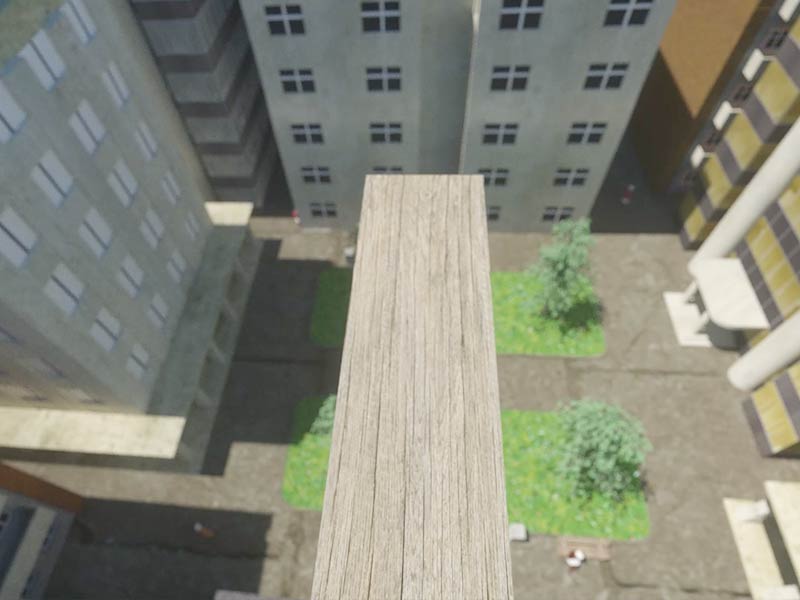
Height
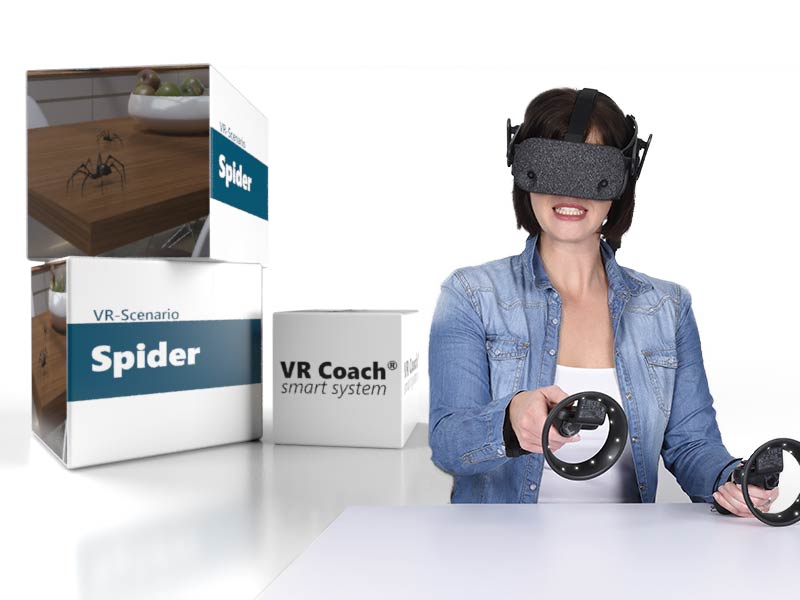
Room with a spider

Treatment of spider phobia
The fear of spiders is widespread. Those affected suffer not only at the sight of a spider, but also every time they go into the cellar or tidy up their living space. The mere possibility of an encounter restricts the quality of life. This scenario is precisely the controlled setting that those affected need for successful treatment.
Description of the scenario
This scenario starts in a seated position. The patient should have already taken a seat before the scenario is started. The patient is then seated on a sofa in the scenario. In front of him, there is a table on which no spider is visible at first.
The therapist can activate the following actions in this scenario:
- Make a spider appear
- Make the spider walk around
- Make the spider walk towards the patient
- Change the size of the spider as required
- Change the speed of the spider as required
- Choose a different spider species
- Lots of spiders coming out from under the sofa
- Let the spider follow the stick
- Let the spider perish
- Make the spider appear on the sofa
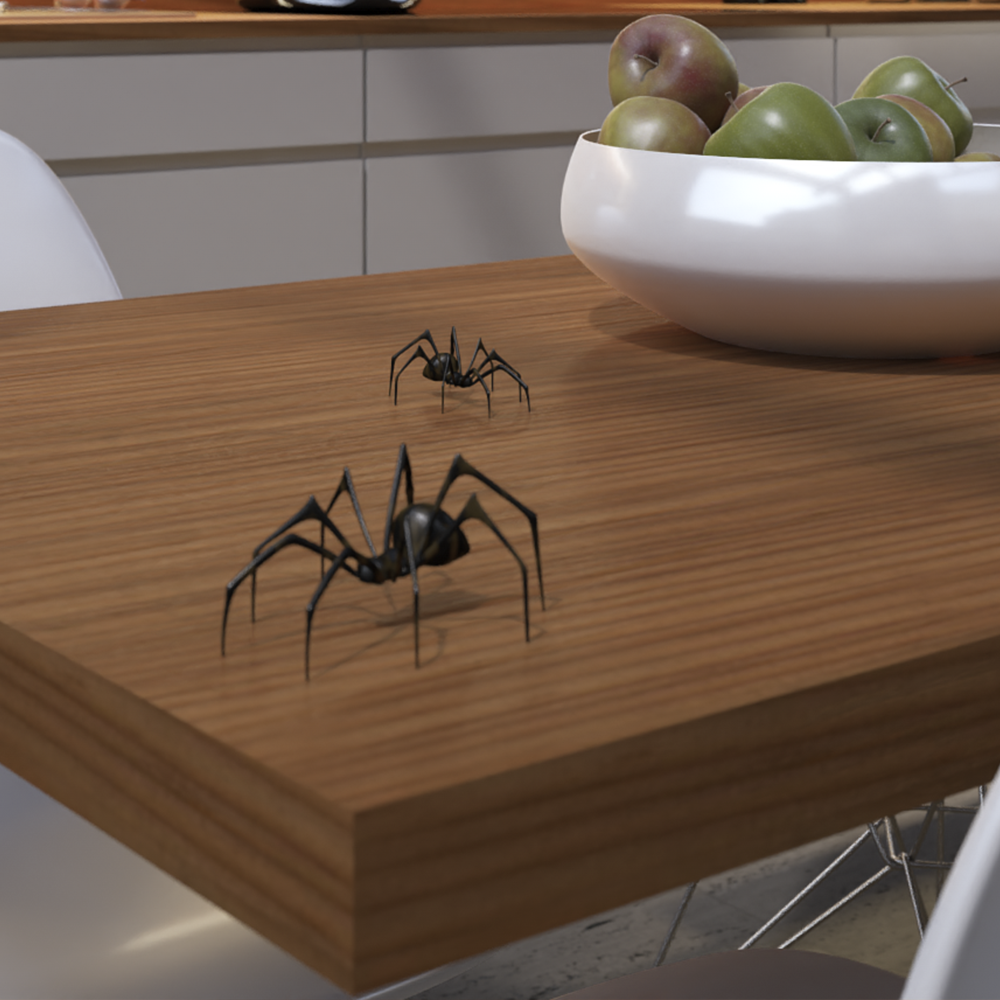



Room with a spider
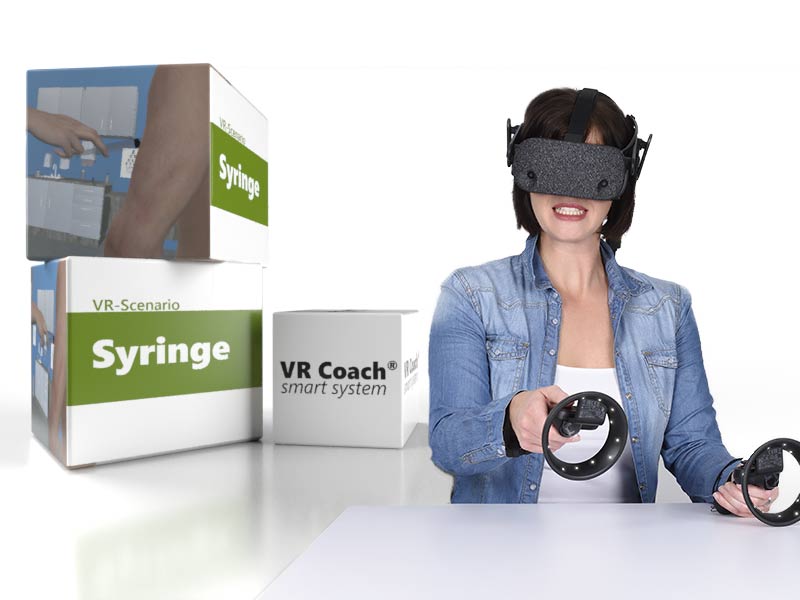
Syringe Scenario

Syringe phobia has several specifications: Fear of needles, fear of blood, fear of pain, fear of doctors. There are probably a few more. With this scenario you can help people to stop letting their fear stop them from wanting to be vaccinated. Alternatively, you can also trigger to take a blood sample.
Description of the scenario
The patient first stands in a treatment room with a doctor standing next to a chair. The patient can go to this chair and sit down. In reality, he sits down on a chair in your practice at this time. As soon as he sits down, he can see a realistic-looking upper body with an exposed left upper arm. The doctor now approaches and administers an injection to the virtual upper arm with a slightly larger syringe than in reality. Or the doctor takes a blood sample.
As a therapist, you can trigger the following actions yourself:
- Make a doctor appear (scenario starts first without a doctor).
- Select whether the upper body should look feminine or male.
The doctor gives an injection into the virtual left upper arm. Or takes a blood draw.
Syringe Scenario
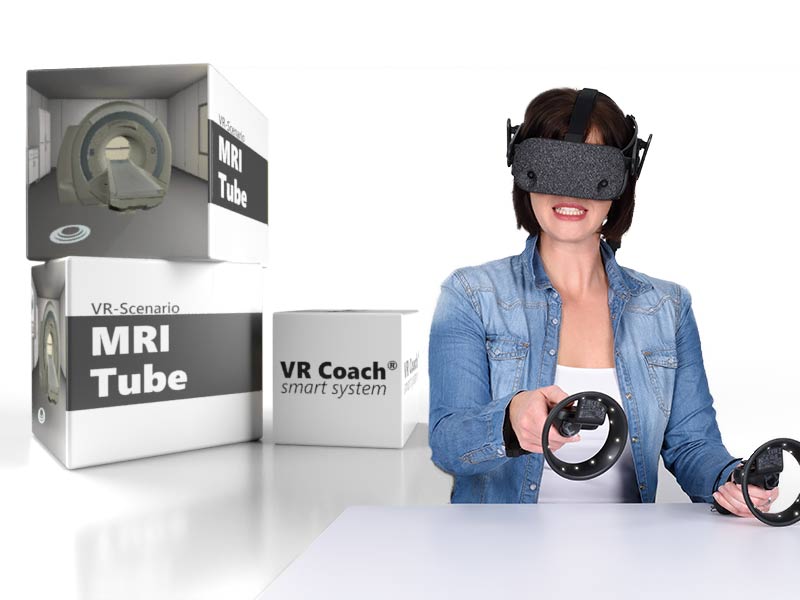
MRI tube

You do not necessarily have to suffer from claustrophobia to find an examination in an MRI tube unpleasant. For people with a fear of confinement, however, it is almost unbearable. The MRI tube is considered a commonly known place of confinement and can therefore also be used for claustrophobics who are confronted with other places of confinement in their everyday life.
Description of the scenario
At the beginning, the patient stands in the corner of the treatment room where the MRI tube is located. He can either go over to the tube himself or jump there using the teleport function. He can look at the tube from close up and put his head in it for a test.
The patient can lie down in your practice. . At the push of a button, you can teleport him to where he has to lie down on the MRI tube. From now on, the patient experiences the rest of the procedure lying down. Including the movement into the MRI machine and the scan in the tube.
As the therapist, you can trigger the following actions yourself:
- Bring the patient into the lying position in front of the MRI tube.
- Let the patient enter the tube
- Start and end the scan
- Size of the tube
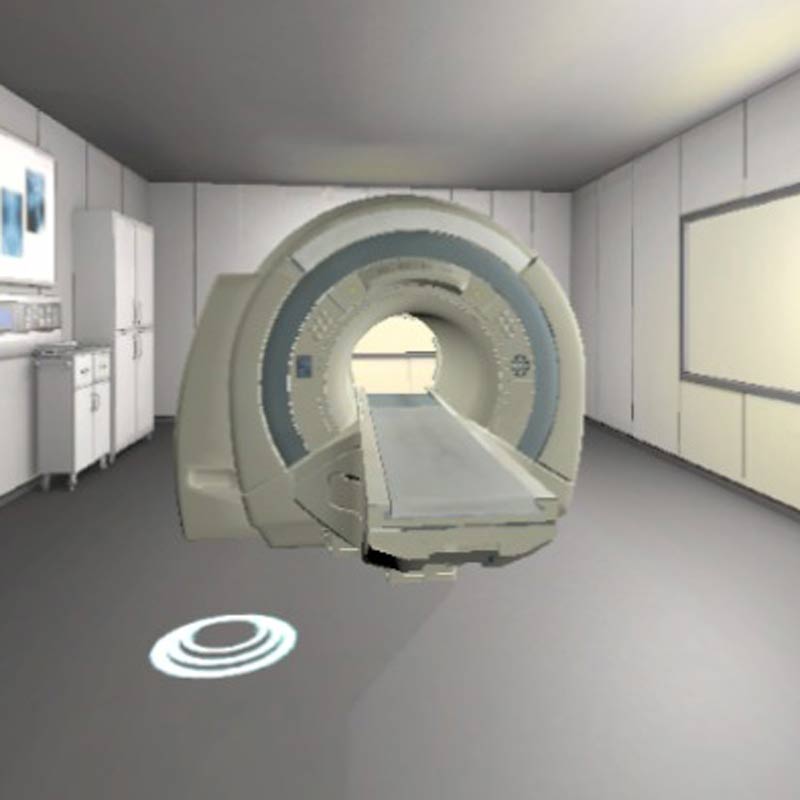
MRI tube
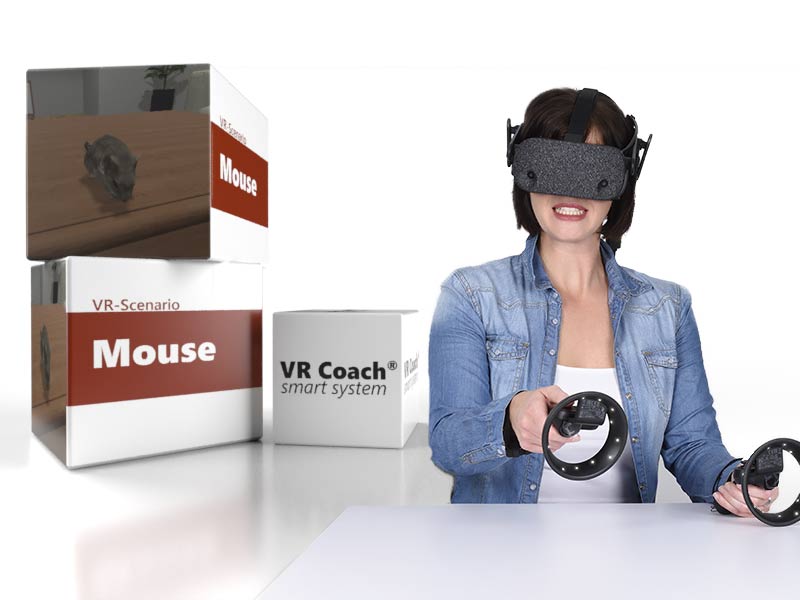
Room with a mouse

For some a cute little mouse, but for those affected, it is a creature that makes them tremble. Since encounters with mice can happen at any time, there is a correspondingly high level of suffering. This scenario provides a controlled setting in which your patients are gently to intensively confronted with a mouse.
Description of the scenario
At the beginning, the patient sits on a sofa and looks at an empty table. . The patient can take another seat and move freely around the room. At the push of a button, the therapist can make a mouse appear on the table and then increase the confrontation through various actions.
The therapist can activate the following actions in this scenario:
- Make mouse appear
- Make mouse walk around
- Let the mouse walk to the patient
- Let the mouse move around the room and around the patient’s feet
- Change mouse size as you like
- Change the speed of the mouse as desired

Room with a mouse
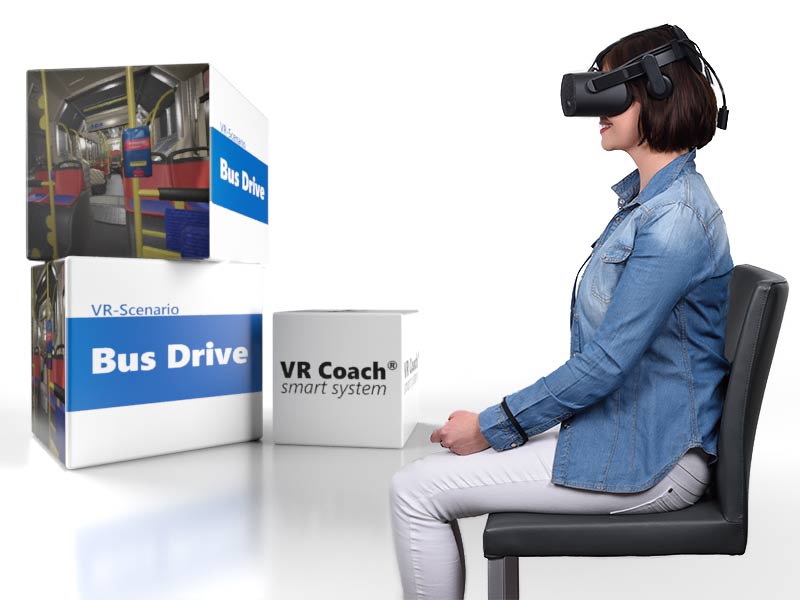
Bus

Travelling on public transport can trigger various fears. For example, travelling alone on a bus to an unfamiliar area is a difficult situation for people with agoraphobia. In the case of social phobias, it tends to be the other passengers who trigger fears. This scenario is suitable for both aspects.
Description of the scenario
When your patient puts on the VR headset and you start the scenario on the computer, your patient will immediately be in a bus right next to the driver.
What is special about this scenario
The bus is computer-generated so that patients can move around freely. However, the landscape outside is real, creating an overall very realistic driving experience. The bus regularly stops at real bus stops and displays these stops on the screen.
The patient has the following possibilities for a high degree of realism:
- Walk through the bus and sit in any seat
- Alternatively, you can also use teleportation to jump directly to these locations
- Of course, look out the window and see a real landscape (green spaces, cars, buildings, people).
- Press the stop button.
The therapist can activate the following actions in this scenario:
- Fade in or out other passengers.
- Optionally, have only teenagers or a mixed group.
- Individual conversations between passengers and patients *
- The passengers are programmed to establish eye contact automatically when the patient approaches them.
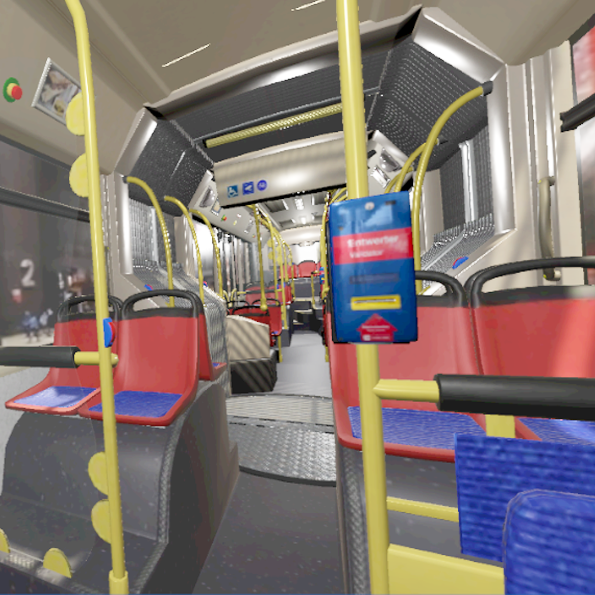
Bus
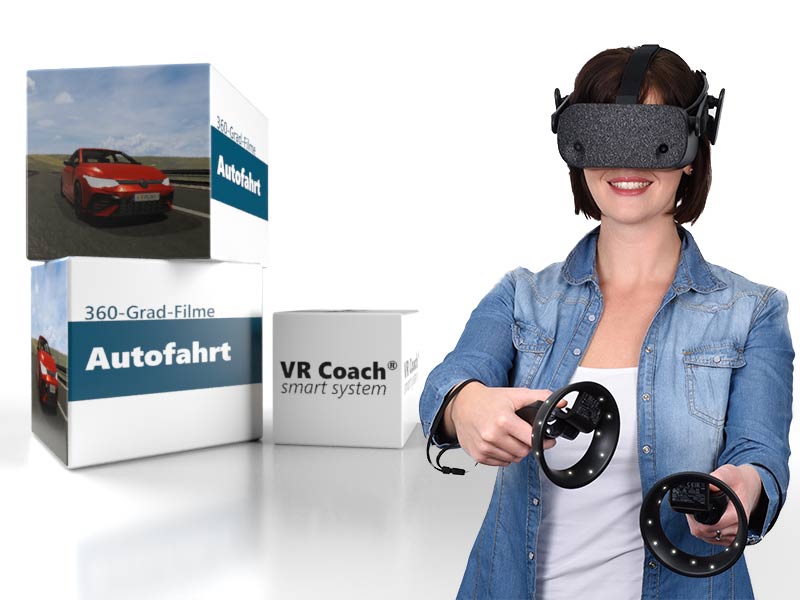
Car Ride

Amaxophobia is a common anxiety disorder where sufferers have a fear of cars or a fear of driving in different situations.
Description of the scenario
When your patient puts on the VR headset and you start the scenario on the computer, your patient is instantly in a car on the motorway. Before you start the scenario, you can already decide whether the journey should begin on a normal stretch of road, in a tunnel or in an area of roadworks. You can also change the scenario during the journey with just one click.
The patient has the following possibilities for a high degree of realism:
- He/She takes the wheel
- Can change the lane
- Can adjust mirror
- Can set the indicator
- Can regulate the speed
The therapist can activate the following actions in this scenario:
- Slow car for overtaking appears in front of patient
- Darkness
- Rain
- Both together
- Another car makes a mistake
- Form a traffic jam
- Speed
>> Here you can find our article with a video on this scenario.
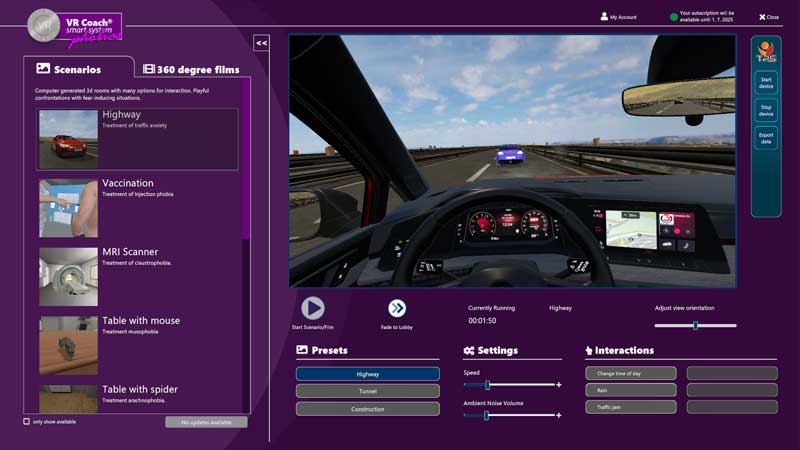

Car Ride
We add new scenarios several times a year.
If you have any special requests, we can even develop individual scenarios or 360-degree films for your very own needs. Please do not hesitate to contact us!
360-Degree Films in VR Therapy
Realistic 360° Films for Immersive VR Exposure Therapy
These films immerse patients in realistic situations. Unlike interactive scenarios, the confrontation is passive, with no active involvement from the patient or therapist. This creates an immersive yet controlled environment for initial steps of confrontation.
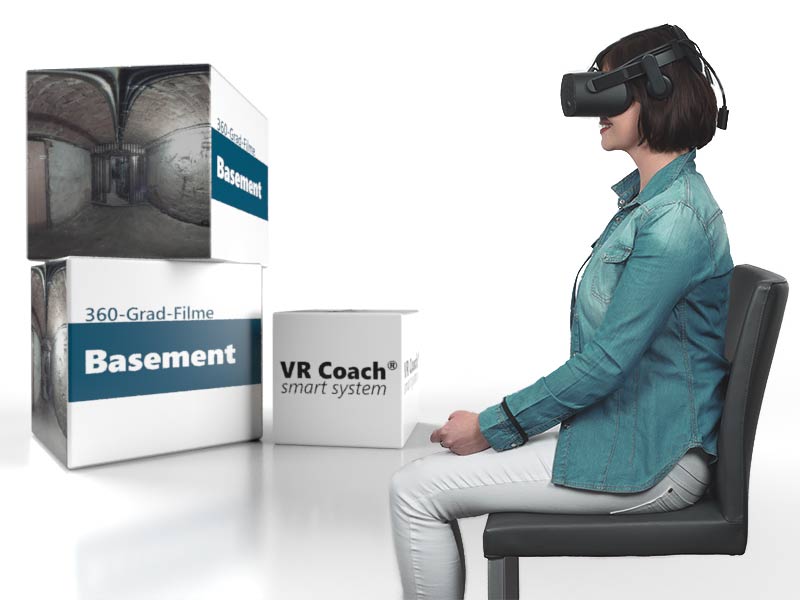
Basement

Basements are often threatening places for many people. Basements are often threatening places for many people. The fears associated with this are varied – spiders, confinement, ghosts, burglars, to name but a few examples. Nevertheless, going into a basement is often unavoidable. With this offer you help your patients to cope with it in a more composed manner.
Description of the basement exposure
The patient stands at the foot of some basement stairs. In the next scene they are in front of an old basement compartment. A change of scene follows, whereupon the patient is then in this compartment. Afterwards the perspective changes. In both perspectives they may be given the task of finding a spider, which is located in certain places. This is followed by further scenes which leads the patient into a dark corridor.
An overview of the scene sequence once again
- In front of the basement stairs (duration: 00:20 minutes)
- In front of a basement compartment (duration: 00:20 minutes)
- In this basement compartment (duration: 02:00 minutes)
- A different perspective in this compartment (duration: 01:00 minute)
- In a corridor (duration: 00:20 minutes)
- At the end of the dark corridor (duration: 00:40 minutes)
Total duration: 04:10 minutes (Alternatively, all scenes can also be played in and endless loop.)
Basement
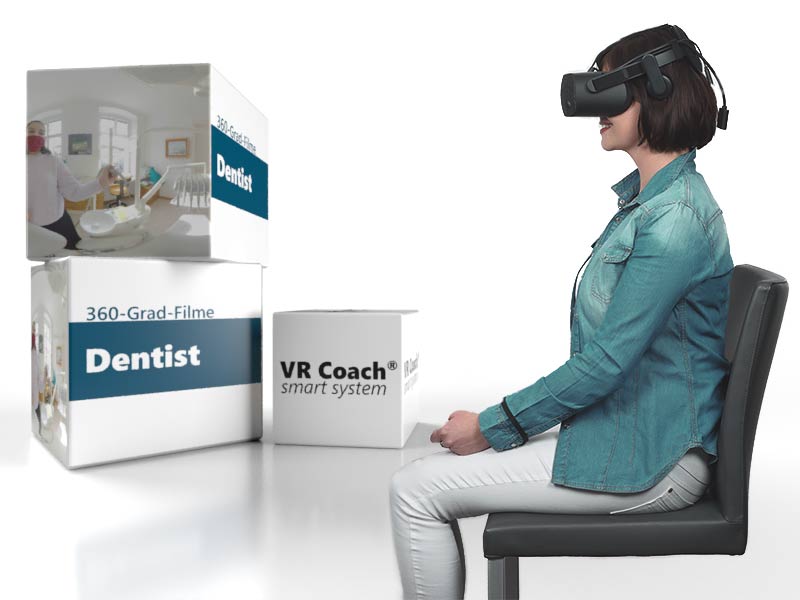
The Dentist

A fear of the dentist leads to disadvantageous avoidance strategies for those affected. In contrast to some other fears, it is not possible to arrange a lifetime of avoidance. With this offer you help your patients to be at an appointment with the dentist on time.
Description of the exposure to the dentist
Der Patient befindet sich zuerst vor der Türe einer Zahnarztpraxis. The door opens, followed by a scene change. The patient now finds themselves sitting in the waiting room. Typical drilling noises can already be heard. This is followed by a change of scene into the treatment room. There the patient is standing in front of the treatment chair. After the next scene change the patient finds themselves sitting in the treatment chair. To the left of them is a dentist’s assistant. Typical drilling and suction noises can be heard.
An overview of the scene sequence once again
- Standing in front of the door (duration: 01:00 minute)
- Sitting in the waiting room (duration: 01:30 minutes)
- Standing in front of the treatment chair (duration: 00:40 minutes)
- Sitting on the treatment chair (duration: 02:00 minutes)
Total duration: 05:10 minutes (Alternatively, all scenes can also be played in and endless loop.)
The Dentist
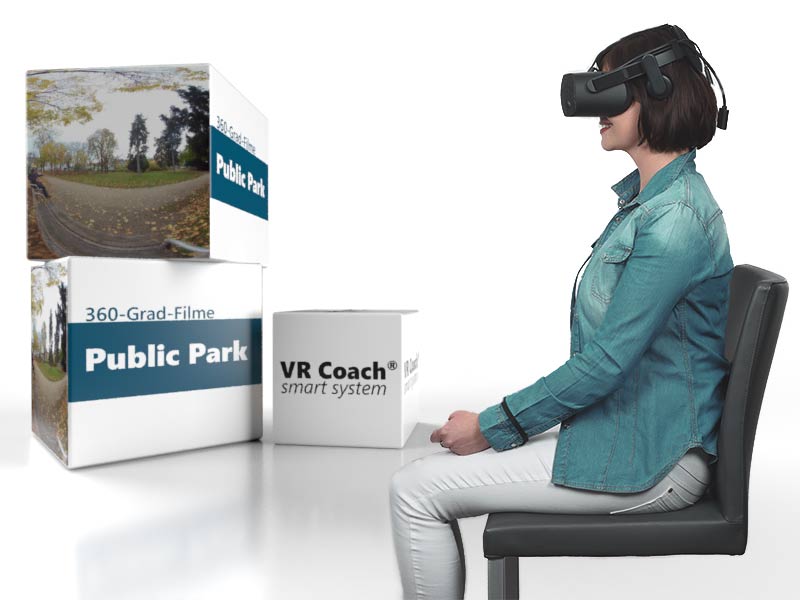
Public Park

Especially for people with a pronounced social phobia, public spaces are hardly accessible. Another problem can be the fear of infections. The result is often an isolated life in one’s own four walls. With this offer you can help your patients to improve their quality of life and health.
Description of the park exposure
Your patient is in only one scene during the entire exposure – sitting on a park bench. What changes is what is happening around them. First, walkers pass by close to the bench. Later, two people take a seat on the neighboring bench and talk. Then another person takes a seat right next to your patient and reads a newspaper. This gradually increases the exposure.
An overview of the increased exposure once again
- The patient is sitting alone on a park bench.
- Walkers pass by closely.
- Two people sit down on a neighboring bench.
- A further person sits directly next to the patient.
Total duration: 08:24 minutes
Public Park
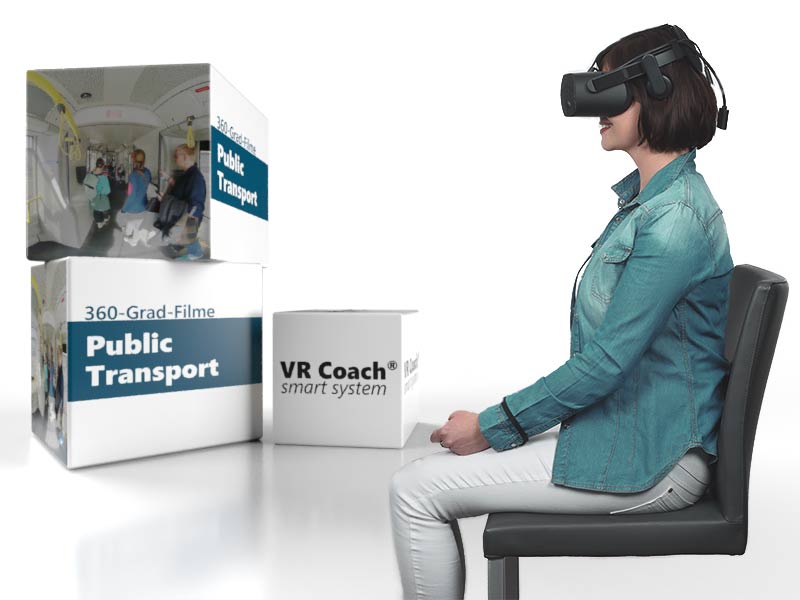
Public Transport

Public exposure description
In the first scene your patient is at a tram stop. The tram comes, the door opens and the first scene change follows. Now your patient is in the tram near other passengers. Some wear face masks, others do not. After some time, there is a change to a bus stop. Then your patient is on the bus and experiences the bus ride from two different perspectives.
An overview of the scene sequence once again
- Tram stop (duration: 01.20 minutes)
- Tram ride (duration: 01.20 minutes)
- Bus stop (duration: 00.58 minutes)
- Bus ride (duration: 00.56 minutes)
- Bus ride from a different perspective (duration: 01.06 minutes)
Total duration: 05:40 minutes (Alternatively, all scenes can also be played in and endless loop.)
Public Transport
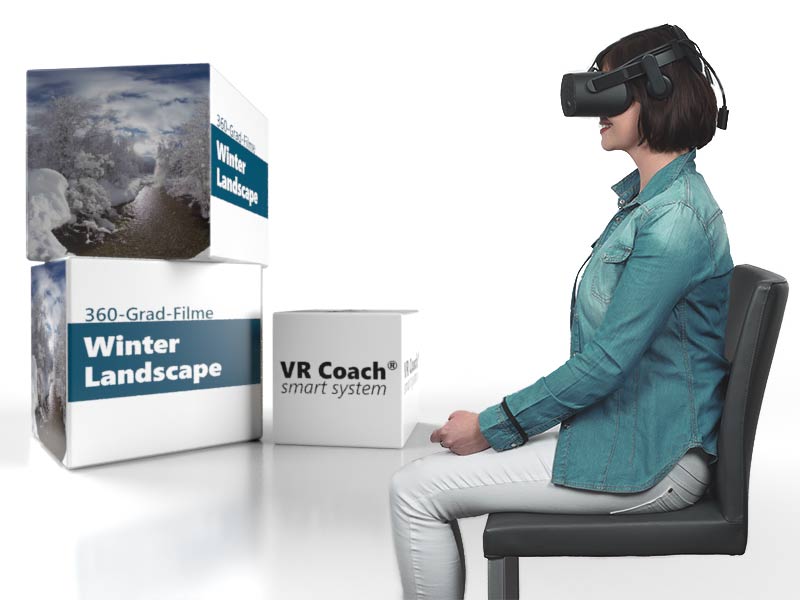
Winter Landscape

Bright sunshine, crisp snow, a sparkling stream and white mountains on the horizon – a place just like out of a winter fairy tale. These scenes, combined with relaxing background music, are the perfect conditions for more peace and serenity.
An overview of the scenes
- View of a large frozen lake
- Snow-covered forest path with trudging sounds
- View of the lake from another perspectiveive
- Wooden bridge with snow falling from a branch into the stream
Total duration: Unlimited
Winter Landscape
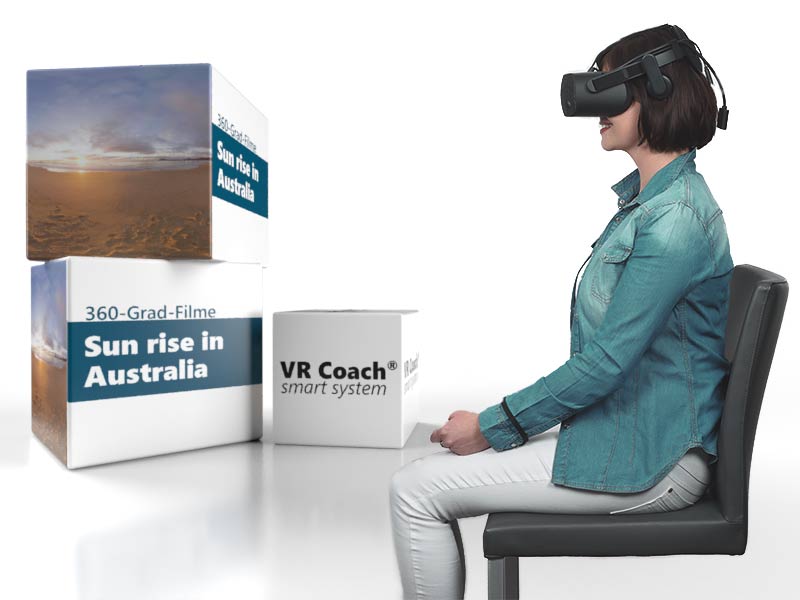
Sun rise in Australia

Many people find spending by the water to be relaxing and pleasant. If this is also possible on a deserted beach in Australia, where you can experience a fantastic sunrise, it will be a very special experience!
An overview of the process
- Your patient is always in the same place.
- They can turn in all directions.
- There are no other noises apart from the sound of the sea.
- Every minute you can observe the sun rising and rising.
Total duration: Unlimited
Sun rise in Australia
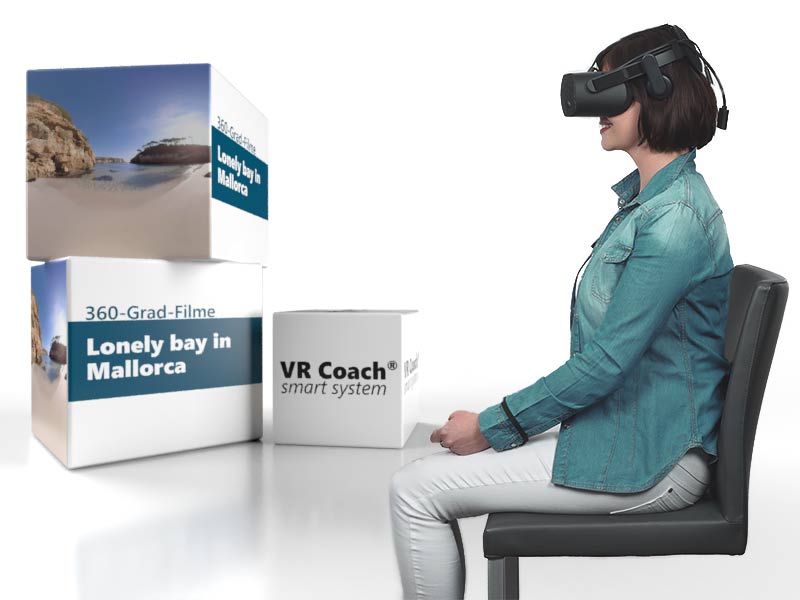
A Lonely bay in Mallorca

To withdraw and leave everyday life behind is a great need for many. In this lonely bay on Mallorca this is absolutely possible! Your patient lets their eyes wander over the water and the small mountains on the horizon. Soothing music and the soft splashing of water will lead them into an ever-deeper state of relaxation.
An overview of the process
- Your patient is always in the same place.
- The rocky surroundings stand for protection and retreat.
- Besides the soft splashing of water, soothing music can be heard.
Total duration: Unlimited
A Lonely bay in Mallorca
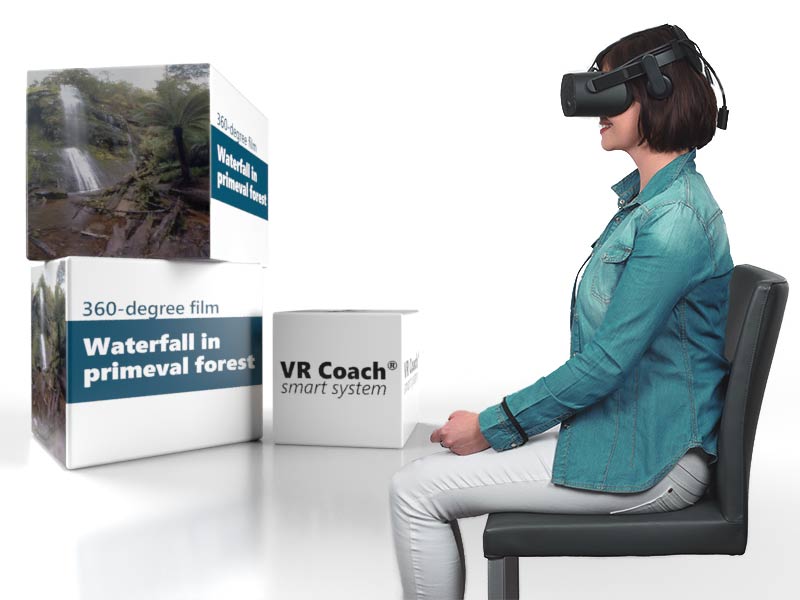
Waterfall in a primeval forest

The trickling sound of water has always been considered a point of attraction for those seeking respite. In this primeval forest, the water flows over a mighty rock face into a small pond from which a stream springs. The site is surrounded by dense primeval forest, but wooden paths lead out of it.
The procedure at a glance:
- Your patient is always in the same place.
- He can turn around in all directions and also look up to the waterfall.
- Only the natural sounds of the water flowing can be heard.
- There are short exercises whereby the patients close their eyes and mentally step under the water for refreshment.
Total duration: Unlimited
Waterfall in a primeval forest
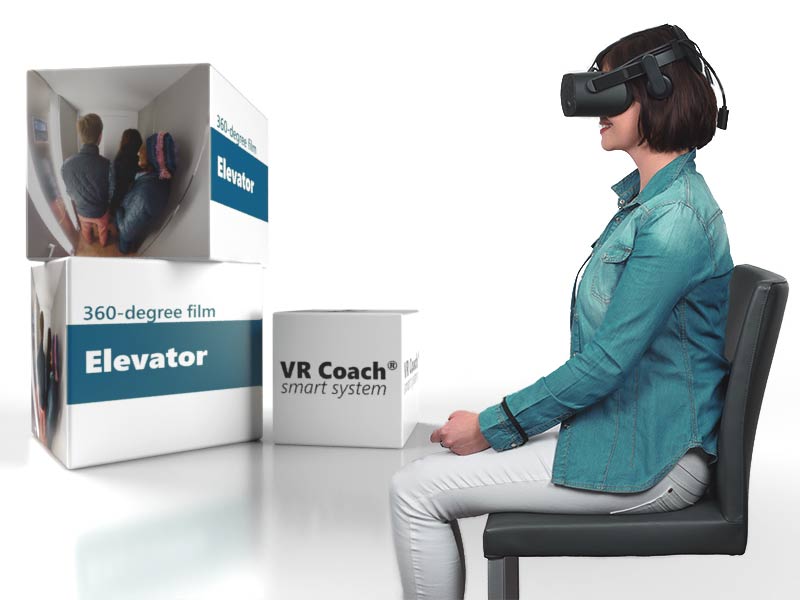
Elevator

Time in a narrow lift is a difficult situation for both social phobics and claustrophobics and is therefore very suited to VR exposure.
Time in a narrow lift is a difficult situation for both social phobics and claustrophobics and is therefore very suited to VR exposure.
The film consists of two scenes:
Scene 1: Patient is alone in the lift
Scene 2: Patient is in the lift together with other people
Both scenes only take about one minute. There is an automatic change from scene 1 to scene 2.
However, as a therapist you can select a single scene and make an endless loop out of it with one click. In this way, each scene can be used independently for as long as you like.
Total duration: Unlimited
Elevator
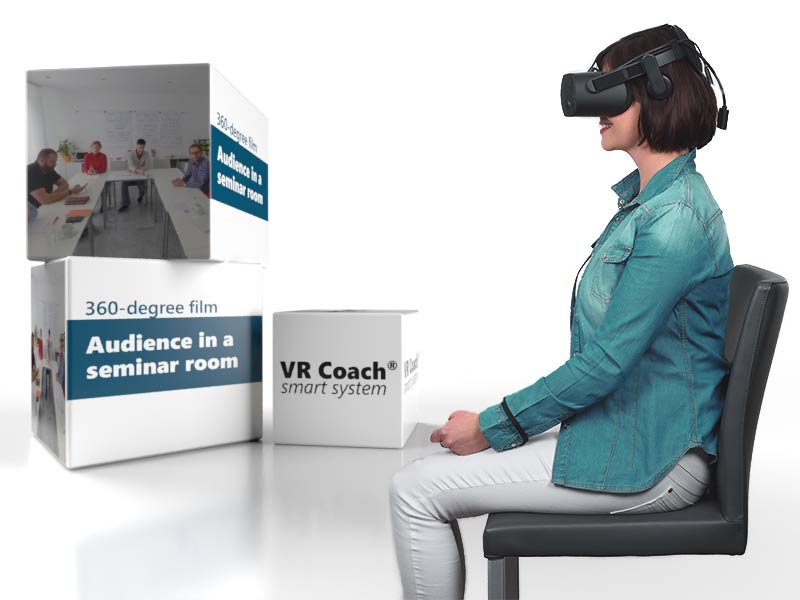
Audience in a seminar room

Many patients find the idea of standing in front of a group of people who are potentially looking at them critically and scrutinising them stressful. In this film, patients expose themselves to critical listeners in a seminar room. The audience alternately behaves uneasily or with increased attention.
An overview of the procedure:
- Your patient is always in the same place (standing in front of the tables).
- He can turn in all directions.
- Only the speaking noises from the audience can be heard.
- When the patient turns around, he is facing a single person who could be, for example, a critical examiner.
Total duration: Unlimited
Audience in a seminar room
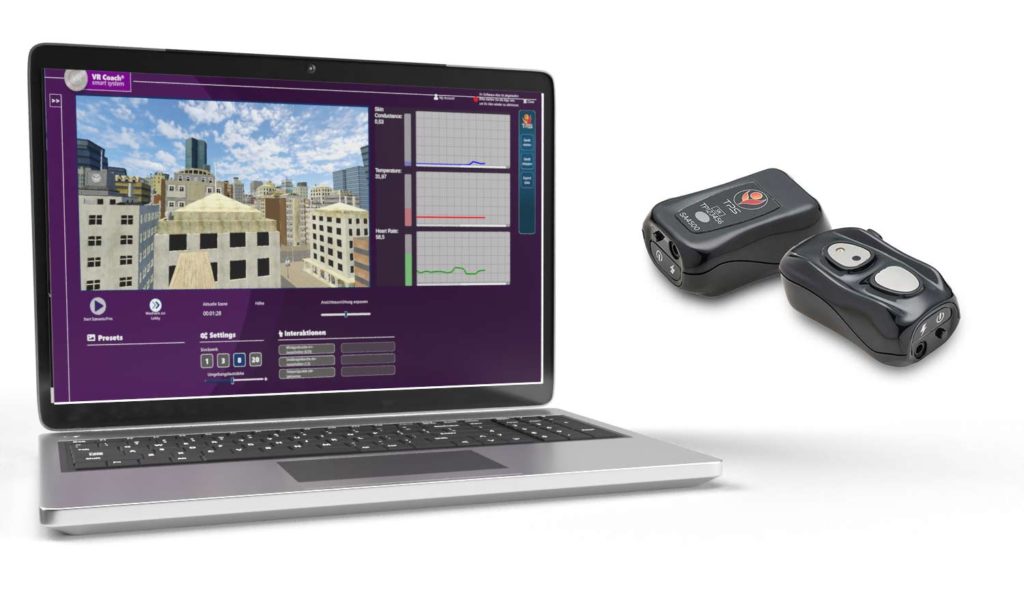
Biofeedback Integration
Real-Time Monitoring for Personalized VR Therapy
The perfect opportunity for setting precise targets and measuring progress.
In all scenarios and films, you have the possibility to view biofeedback data of your patients in a new screen. Namely HRV, temperature and skin conductance.
The required evu TPS finger sensor is available from us.

Learn about our flexible pricing models for the VR therapy software now.
As soon as you have suitable hardware, you can immediately install our software and get started.
We would be happy to advise you personally and work together to find the right model for your facility.
What else you should know - FAQs
Here you will find answers to the most frequently asked questions about our VR therapy software, its application, and integration into therapeutic practice.
What content does the VR therapy offer?
VR Scenarios and 360-Degree Films Comparison
Interactive VR Scenarios for Flexible Therapy Design
VR scenarios are realistic, computer-generated environments where your patients can move freely, grab objects, and solve tasks. This form of interactive therapy allows for a gradual confrontation with anxiety-inducing situations, individually tailored by the therapists. Scenarios can be live-controlled and altered in real-time on a computer – for example, for treating phobias or promoting coping strategies.
360-Degree Films for Passive Exposure and Relaxation
In contrast, 360-degree films offer pre-recorded scenes in which patients do not perform active actions. They look around the environment but are observers. These contents are particularly suitable for calm, structured exposures or relaxation exercises in natural settings. Both options complement each other and expand the potential uses of the VR therapy software in clinics and practices.
Can the software be tailored to the patient's readiness?
Flexibly Customizable VR Scenarios for Gradual Exposure
The VR therapy software offers extensive customization options to adjust the exposure to the individual progress of patients. Elements such as stimuli, difficulty level, or dialogues within the scenarios can be easily modified.
Interactive Therapy for Different Levels of Distress
Whether it’s the size of a spider or the behavior of passengers on a bus – depending on the phobia or disorder, suitable elements can be selected and adjusted. This allows for a customized and therapeutically grounded VR psychotherapy experience.
How safe is the use in a therapeutic setting?
VR Therapy in a Controlled and Protected Environment
The use of the VR therapy software is carried out exclusively under therapeutic supervision. The exposures can be interrupted, adjusted, or terminated at any time – directly through the PC software.
Safe Treatment of Phobias in Practice or Clinic
Although real emotions are triggered, the environment remains fully virtual. This provides maximum safety when treating phobias and anxiety disorders – without real risks for patients.
Which phobias are covered by the VR scenarios?
Diverse VR Scenarios for Specific and Social Phobias
The software covers the most common phobias, including spider phobia, fear of heights, social anxiety, and agoraphobia. All content is based on current findings from behavioral therapy.
Treatment of Phobias with Interactive VR Therapy
Our VR scenarios enable targeted confrontation with anxiety-inducing stimuli. The offering is continuously expanded to allow for a broader treatment of phobias.
Is the use also possible for adolescents or older patients?
VR Therapy Flexible for Use with Different Age Groups
The content of the VR therapy software is generally age-independent. Therefore, it can also be used with adolescents or older patients.
Technical Adjustments for Younger User Groups
For very young patients, the size of the VR headset may be a limitation. Therefore, we recommend using the VR headset from around 12 years old, when handling becomes easier.
How is the control managed by the therapist?
Full Control through Intuitive PC Control
The VR therapy software is installed on a PC or laptop. Therapists select the appropriate scenario and can control every function in real-time.
Insight into the Process and Real-Time Biofeedback
Through a screen, therapists can see exactly what the patient is experiencing in the VR. Additionally, biofeedback data can be displayed to specifically interpret and guide the patient’s response.
Are there regular new contents or updates?
Regular Expansion of the VR Therapy Software for Modern Psychotherapy
Our software is continuously being developed. New VR scenarios and features are released 2–3 times a year. This ensures that our VR therapy remains up-to-date – for long-term, professional use in clinics and practices.



